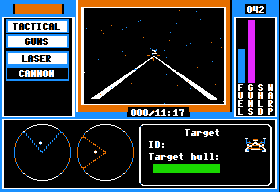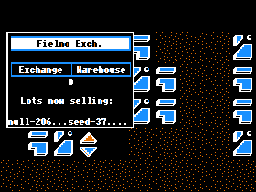Space is a tough place where wimps eat flaming plasma death. It's happened to me a lot lately, but I've learned a lot about SunDog: Frozen Legacy's economy in the process, even though I have yet to make any real star bucks.
You make money buy purchasing cargo low and taking it somewhere it will sell high, but there are two problems. The first is a problem of incomplete information - you might see a load of cereals offered for $1,700 at the Drahew exchange, but then you need to know where you can sell it at a profit. There are three ways of finding out what goods are worth at a given city, all of them with some disadvantages.
- First, the commodity exchanges have tickers that show what goods are selling for. You won't see all of the goods this way, and it doesn't show the goods' quality, which affects price, so at best you'll get a ballpark range. The ticker moves fast too, so writing things down is tricky.
- Second, you can enter the exchange as a buyer, and deals will be offered to you directly. This shows you the quality of what's being offered, but you'll only see a random subset of the trades shown on the ticker, and only trades that you've got the cash on-hand to afford.
- Third, you
can take any good to any exchange and find out directly what you can
sell it for there. This is always a fraction of its purchase price - a
fraction which varies from good to good (and possibly city to city).
Visiting
every starport to query purchase prices is an expensive proposition.
You can expect a single intersystem trip to use up half of a fuel tank,
or about a $900-$2000 refuel charge depending on the city. This is
somewhat viable, as Zed's uncle left cash here and there at various
banks throughout the galaxy, but eventually you've got to start making
money.
What you certainly can't afford to do is transport
goods to every starport to query prices that way. As useful as it would
be to find out the highest and lowest prices of a specific commodity, the second problem you must contend with as a space freighter is also the reason you can't do that;
transporting goods gets pirates on you like stink on a wookie, and space
combat is borderline unsustainable. Your ship has enough space to carry
two container loads, and if I allocate one to auxiliary fuel and the
other to cargo, I'm lucky if I drift into the dock at my destination
blasted half to scraps and running on fumes. On a blind run there's no
guarantee that the cargo will even sell at a profit, let alone enough of
one to completely repair, refuel, and be in a better position than when
you started. Transporting two loads of cargo, leaving no room for auxiliary fuel, seems completely impossible.
By the numbers, I estimate that a full fuel tank holds 64 of what I'll call liters. Fuel is sold by "units," and a full tank holds 16, but fuel depletes in smaller increments than that. Your main tank automatically refills when empty if you have any auxiliary fuel, and as mentioned, you can only hold one if you have a single load of cargo. So, for all intents and purposes, you can bring 128 liters of fuel on a single freight run. And you'll need about 32 of them just for travel, assuming your ship is in perfect working condition - a costly initial investment.
A typical intersystem trip involves taking off from your departure planet, cruising to a warp node on sublight drives, warping to your destination system, cruising to the destination planet on sublight drives, and landing. If you carry any cargo at all, you're guaranteed at least one pirate encounter on each of the sublight trips, probably two, and this is where the real fuel guzzling happens.
 |
| Missing a pirate |
Simply being in the vicinity of a pirate slows you down, which means more fuel is consumed for the trip, and any system component damage further reduces your fuel efficiency. Switching to combat mode requires navigating a cumbersome system of menus in realtime, while coasting on precious fuel and being shot at. Shooting back - you can fire lasers or cannons but I don't see what the difference is - costs two liters per shot, and forget about using shields; merely having them up at the minimum strength will drain half a tank in less than a minute, and that's on top of fuel burned by your engines and guns. At maximum shield strength you'll burn ten liters every four seconds!
I don't know if I'm just doing combat wrong, but making a trip with two loads of cargo and a single full tank seems to be completely impossible. Combat is a simple system where you rotate your craft to face your target, using radar to guide you, and then align it in your crosshairs and fire your guns. There is nothing you can do to avoid taking hits except kill it faster or raise shields. At my absolute best performance, I'll lose a good 4-5 liters just from navigating the combat menu to switch to the tactical view, arming my guns, and then rotating to face the pirate, and after that, I'll waste the better part of a tank shooting and mostly missing the pinpoint precision needed to score a hit. If you win but don't have enough fuel to make it the rest of your way to the destination, you can send a distress signal and get a free refuel. If you run out mid-combat, you're dead.
Alternatively to combat, you can try to talk your way out, and this is certainly the better option. You could jettison your cargo, if you don't mind that the game will basically be over if you do this. You can also bluff, threaten, or fast-talk, and in my experience, only bluff ever works. Taking charisma pills slightly increases the success rate, but not enough to be worth the $6000 or so that they cost.
I did some scouting around the galaxy, visiting starports without cargo, just to check on the prices of cargo, goods, and services, and in the process got a better understanding of how the economy works in this game.
- There
are 18 planets, split over 12 systems. Most planets have multiple
cities, but each has exactly one starport, which is the only place the
SunDog may land.
- Each city has two invisible and independent factors that determine multiple aspects of the economy, which I will call "inflation" and "fuel rate." Neither seems to determine commodity prices, unfortunately.
- Inflation determines the prices at general stores and ship stores, and works as a simple multiplier. Determining it is as simple as attempting to buy a good from such a store and doing math; if a control node costs $1,520 on Drahew and $2,660 on Malesti, this means Malesti has an inflation rate of 175% and you can expect all goods at these stores to charge 75% more than on Drahew. The lowest prices I've seen were 50% of Drahew rates. Inflation does not affect fuel prices.
- Fuel rate is set on a per-system basis - all starports in a system charge the same fuel prices.
- Fuel
prices also determine availability of black market goods. The lower the fuel
price, the more items will be available. Most systems only offer drug
types to boost your four core stats - strength, intelligence, dexterity,
and charisma. Systems with the lowest fuel prices also have illegal
ship modifications - concentrators, autoslews, clokers [sic], and ground
scanners. Systems with the highest fuel prices may only carry
brawnboosters and brainboosters.
I hadn't mentioned the "pod" before, as I hadn't quite grasped how it works until the writing of this post.
- The "pod" is a ground vehicle that detaches from the SunDog. You may drive it around town or walk on foot. Any building may be entered on foot, but only depots and exchanges may be entered driving the pod, and you must to pick up or deliver cargo.
- If you purchase cargo at an exchange without the pod, it will be stored
in an attached warehouse, where it can be retrieved for free later.
- Some warehouses store cryogens. These are free to pick up in your pod, but as I don't even know where to take them, I am just leaving them for the time being.
- If you visit a depot on foot, you may refuel and repair the SunDog's hull. But you must be in the pod to buy auxiliary tanks.
Some more notes on how cities work:
- Banks
safeguard your money for you, and funds in the bank can be spent at
exchanges or depots without needing to withdraw first. Each of the
twelve systems has its own bank system, and you can transfer funds to a
remote system, but not from one.
- Bars will sell you cheap
food and ale, but by requesting "information" you may get access to a
black market dealer. The bartender may or may not request a bribe, but
will usually connect you for free if you buy an ale first. Prices seem
to be somewhat random, but everything I've looked at costs between $2000
and $9999. I have not looked at these prices extensively enough to
determine if there is a pattern, or if local economy affects them.
Needless to say, these places are cash-only.
- General stores
sell rapidheals and stinger pistols. They are always in stock, and they
never carry anything else as far as I can tell. Prices are determined by
inflation; on Drahew a stinger costs $400 and a rapidheal costs $480.
- Ship
stores sell shunts and replacement parts, which vary in price from $96
to $1,520 on Drahew. Prices on other worlds are also determined by
inflation. Not all parts are available in all stores, and their
inventories don't seem to be determined by economic factors. Drahew's
stores have complete inventories.
- Sometimes you encounter people on the street. The few times that I allowed them to approach, they turned out to be muggers, who might be scared off if you have a gun and threaten them. Or they might just be unfazed and gun you down. If there are other types of encounters, I wouldn't know, because I always run away before they can speak.
 |
| Vultures, vultures, everywhere. |












No comments:
Post a Comment
Commenting with signin or name/URL is encouraged but not required. If the spam filter deletes your legitimate comment, apologies - it does that sometimes.